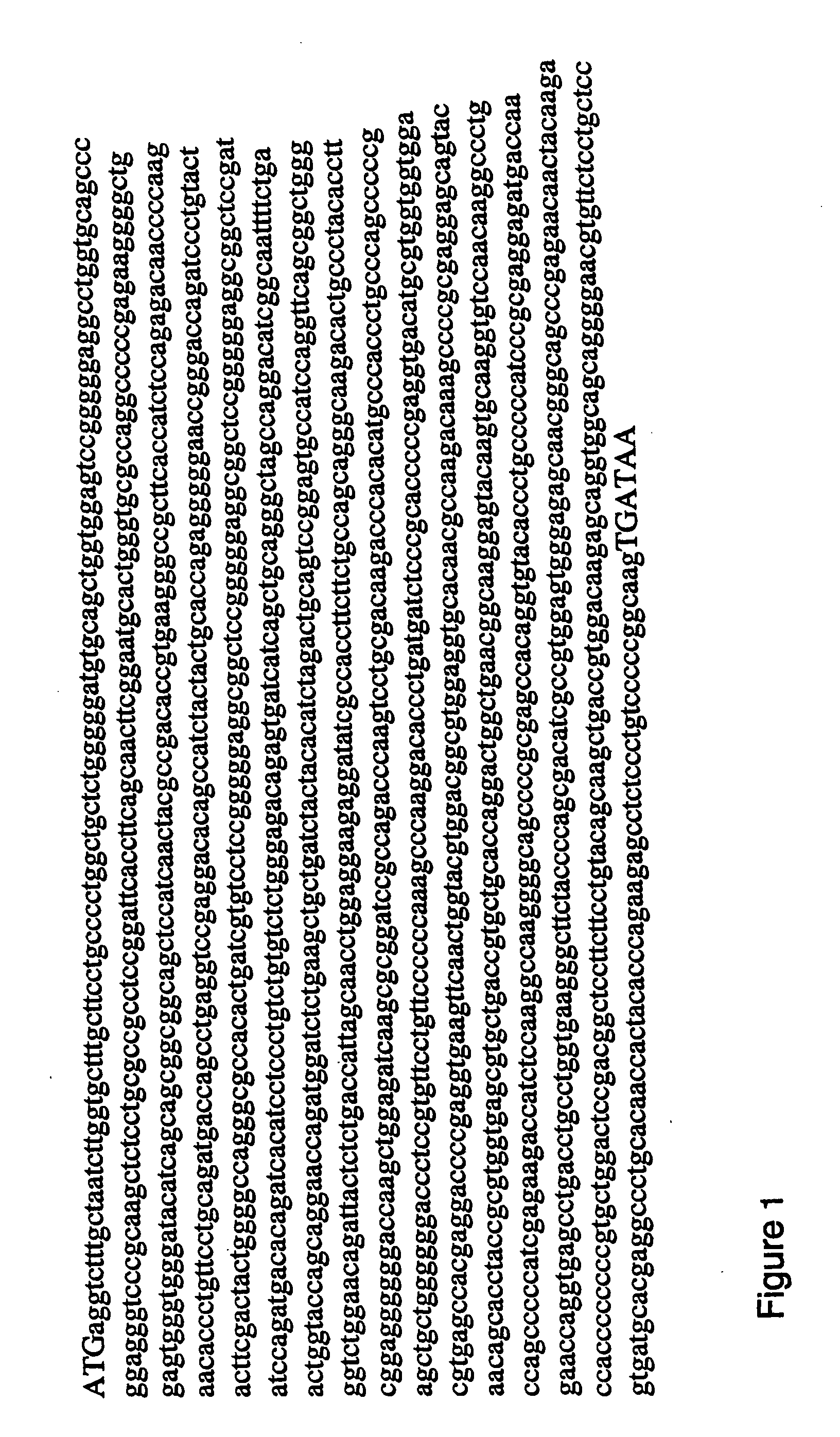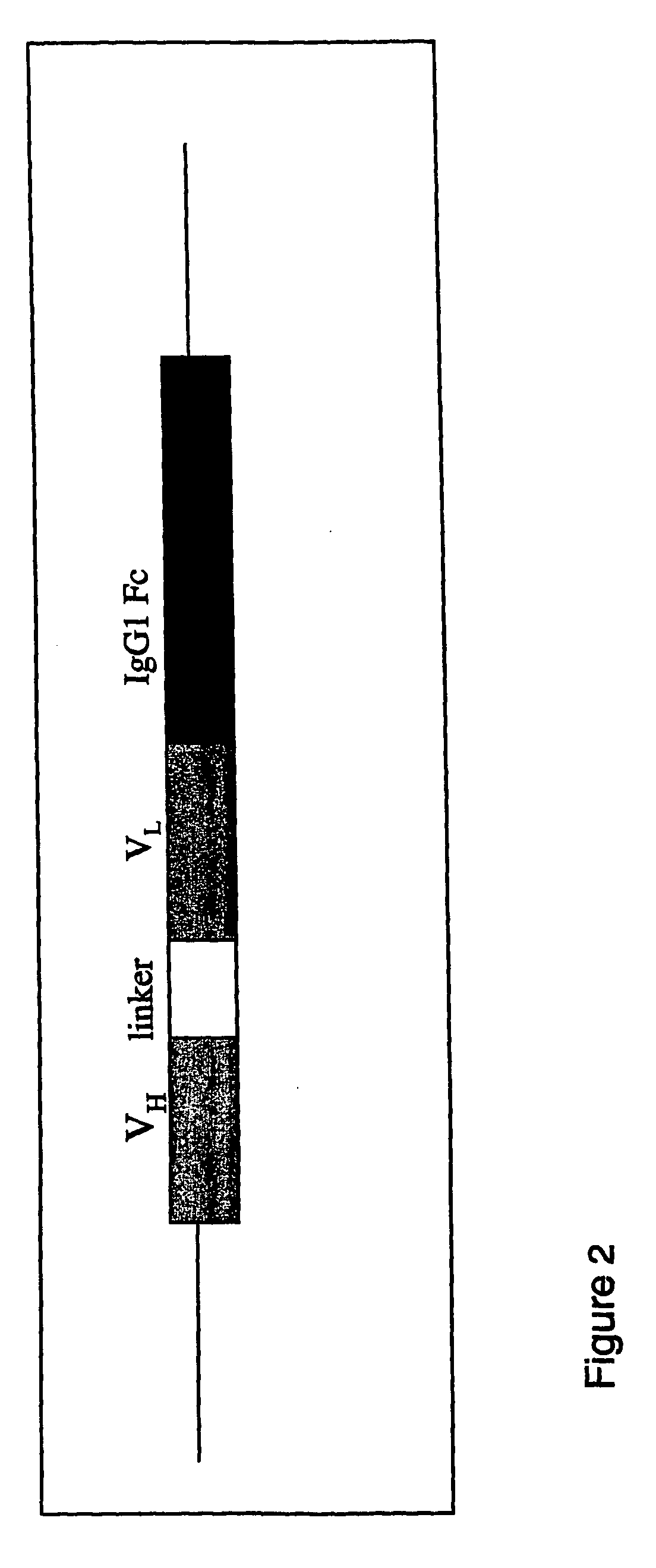Method for Improved Transgene Expression
a transgene and expression technology, applied in the field of improved transgene expression, can solve the problems of drug adverse reactions, lower capital outlay for a transgene animal production facility than for cell culture, and lower production cost per unit of transgene therapeutics
- Summary
- Abstract
- Description
- Claims
- Application Information
AI Technical Summary
Benefits of technology
Problems solved by technology
Method used
Image
Examples
example 2
Interpretation of the R24 Minibody Sequence Data from pRI28
[0158]In the R24 minibody, there are two categories of such potentially problematic short, direct repeat sequences, those within the scFV region itself (VH, linker and VL) and those within the IgG1 Fc domain. The schematic structure of the R24 minibody is shown in FIG. 2.
VH Domain
[0159]Four problematic repeats were identified in the R24 minibody sequence within VH—the first lies at the extreme 5′ end (LP, Leu Pro in FIG. 9, involved in deletion lt16), the second lies within CDR2 (KG, involved in deletion lt15), the third in FW3 (DT involved in deletion lt11 and 13) and the fourth at the 3′ end of VH prior to the linker sequence (LI, involved in deletion lt1).
Linker / VL Domain
[0160]Four problematic repeats were identified in the linker and VL domain. The first lies within the linker (GS in FIG. 10, involved in deletion lt4 and 5), the second lies within FW1 (LS, involved in deletion lt6), the third in CDR2 (TS involved in dele...
example 3
“Repaired” R24 Minibody
[0164]To try and establish the relevance of short, direct repeats and associated deletions it was decided to remove the lt1 sequence (5′CTG ATC 3′) from the R24 minibody sequence and simultaneously replace the linker with the non-repetitive sequence. The effects of this repair were then tested in the vector designated as pLE38 as the lt1 deletion event had been shown to be present in a significant proportion of packaged RNA genomes.
[0165]Digestion of pLE38 with the restriction enzyme BspEI allows a removal of the 5′ lt1 repeat sequence and old linker, and replacement with a new piece of DNA encoding the new linker and in which the lt1 sequence has been removed (see FIG. 12). The full sequence of the replacement segment of DNA inserted into pLE38 to generate “repaired R24” is given in FIG. 13. The completed plasmid was called pLE56.
[0166]The set of two plasmids, repaired and unrepaired were then packaged side by side and the structure of RNA genomes and integra...
example 4
Anti-CD55 Minibody (791T / 36)
[0170]Numerous potentially non-EIAV compatible sequences have been identified as a consequence of work with the R24 minibody. It was of interest to determine whether such sequences would be present in a non-R24 based transgene. Therefore, the anti-CD55 minibody DNA sequence was assessed in order to determine whether the potentially non-EIAV compatible sequences identified in R24 could be applied to another transgene and as such if deletions would be predicted to occur in its sequence when incorporated into an EIAV lentiviral vector backbone. A direct sequence comparison was carried out between this minibody and the R24 minibody. Eight problematic regions were identified in the minibody and these regions are summarised in FIG. 14.
[0171]Line 1 of the table of FIG. 14 shows a perfect match between the residues involved in the lt16 deletion event in the R24 minibody and the CD55 minibody. This is because these residues are encoded by the basic lysozyme signal...
PUM
 Login to View More
Login to View More Abstract
Description
Claims
Application Information
 Login to View More
Login to View More - R&D
- Intellectual Property
- Life Sciences
- Materials
- Tech Scout
- Unparalleled Data Quality
- Higher Quality Content
- 60% Fewer Hallucinations
Browse by: Latest US Patents, China's latest patents, Technical Efficacy Thesaurus, Application Domain, Technology Topic, Popular Technical Reports.
© 2025 PatSnap. All rights reserved.Legal|Privacy policy|Modern Slavery Act Transparency Statement|Sitemap|About US| Contact US: help@patsnap.com



